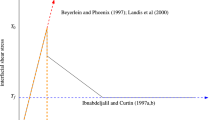Abstract
The role of fibre morphology, interface failure and void nucleation mechanisms within the matrix on the deformation and fracture behaviour of discontinuous fibre-reinforced composites was numerically investigated. The matrix was modelled using a constitutive relationship that accounts for strength degradation resulting from the nucleation and growth of voids. For the matrix, two materials exhibiting identical strength and ductility but having different void-nucleation mechanisms (stress-controlled and strain-controlled) were considered and fibres were assumed to be elastic. The debonding behaviour at the fibre interfaces was simulated in terms of a cohesive zone model which describes the decohesion by both normal and tangential separation. The results indicate that in the absence of interface failure, for a given fibre morphology the void nucleation in the matrix is the key controlling parameter of the composite strength and ductility, hence, of the fracture toughness. The weak interfacial behaviour between the fibres and the matrix can significantly increase the ductility without sacrificing strength for certain fibre morphology and for certain matrix void-nucleation mechanisms.
Similar content being viewed by others
References
T. Christman andS. Suresh,Mater. Sci. Eng. 102A (1988) 221.
C. P. You, A. W. Thompson andI. M. Bernstein,Scripta Metall. 21 (1987) 181.
S. V. Nair, J. K. Tien andB. C. Bates,Int. Metall. Rev. 30 (1985) 275.
D. L. Davidson,Metall. Trans. 18A (1987) 2115.
M. N. Gungor andP. K. Liaw (eds), “Fundamental Relationship Between Microstructure and Mechanical Properties of Metal Matrix Composites” (TMS Warrendale, PA, 1991).
J. T. Barnby andE. Smith,Met. Sci. J. 1 (1967) 1.
A. S. Argon, J. Im andR. Safoglu,Metall. Trans. 6A (1975) 825.
S. H. Goods andL. M. Brown,Acta Metall. 27 (1979) 1.
F. A. McClintock,J. Appl. Mech. 35 (1968) 363.
J. R. Rice andD. M. Tracey,J. Mech. Phys. Solids 17 (1969) 201.
W. A. Spitzig,Acta Metall. 38 (1990) 1445.
V. Tvergaard,ibid. 38 (1990) 185.
J. Llorca, A. Needleman andS. Suresh,ibid. 39 (1991) 2317.
J. M. Papazian andP. N. Adler,Metall. Trans. 21A (1990) 411.
S. B. Biner,Mater. Sci. Eng. A156 (1992) 21.
A. L. Gurson, PhD thesis, Brown University (1975).
Idem, J. Eng. Mater. Technol. 99 (1977) 2.
V. Tvergaard,Int. J. Fract. 17 (1981) 389.
Idem, ibid. 18 (1982) 237.
V. Tvergaard andA. Needleman,Acta Metall. Mater. 32 (1988) 157.
C. C. Chu andA. Needleman,J. Eng. Mater. Technol. 102 (1980) 249.
D. Peirce, C. F. Shih andA. Needleman,Compos. Struct. 18 (1984) 887.
A. Needleman,J. Appl. Mech. 54 (1987) 525.
V. Tvergaard,Mater. Sci. Eng. A125 (1990) 203.
A. Needleman,J. Appl. Mech. 39 (1972) 964.
R. E. Smelser andR. Becker, in “Abaqus User Conference Proceedings” (Hibbitt, Karlsson and Sorensen, Inc., Pantucket, RI, USA, 1990) p. 207.
Author information
Authors and Affiliations
Rights and permissions
About this article
Cite this article
Biner, S.B. The role of interfaces and matrix void nucleation mechanism on the ductile fracture process of discontinuous fibre-reinforced composites. J Mater Sci 29, 2893–2902 (1994). https://doi.org/10.1007/BF01117598
Received:
Accepted:
Issue Date:
DOI: https://doi.org/10.1007/BF01117598




